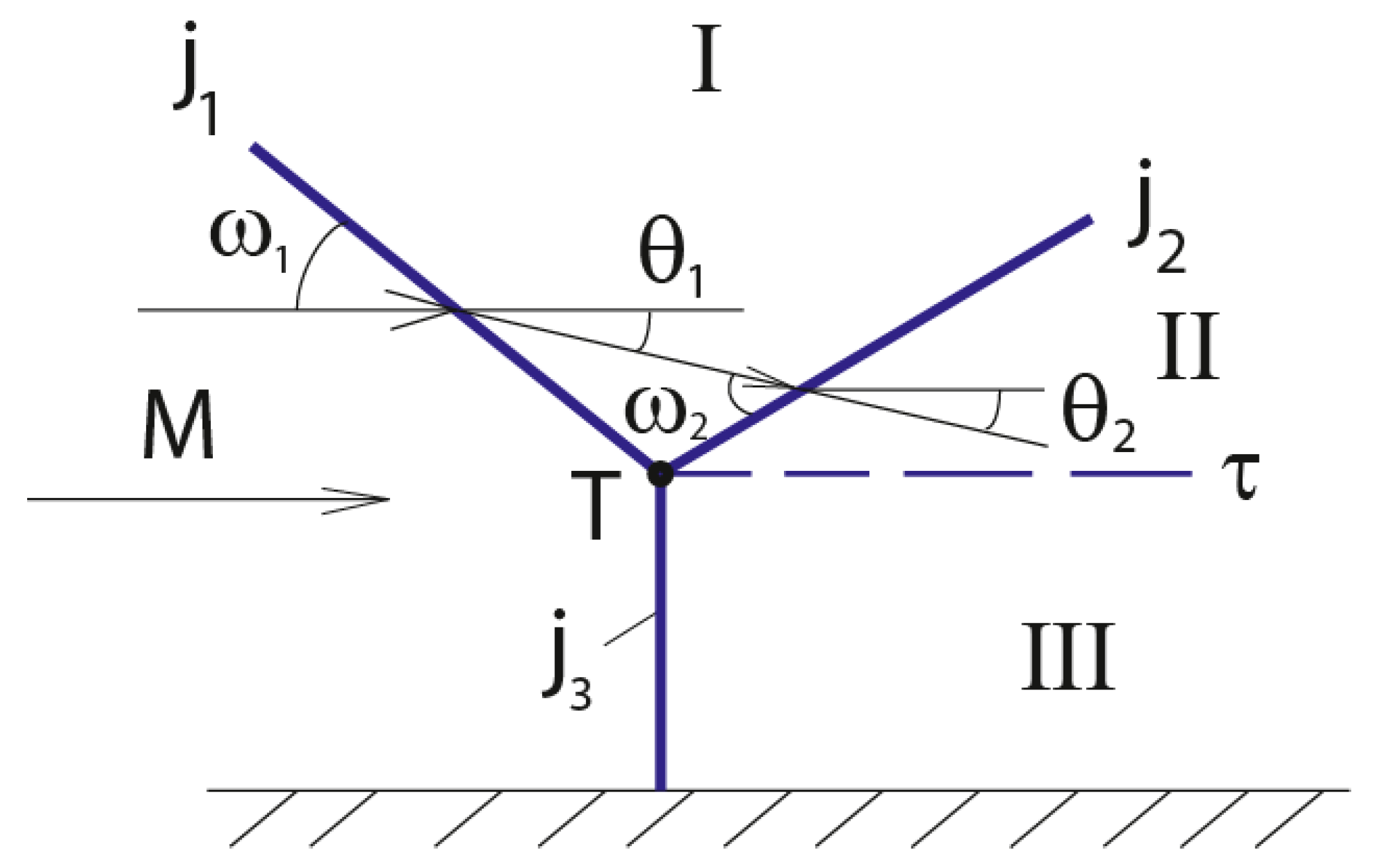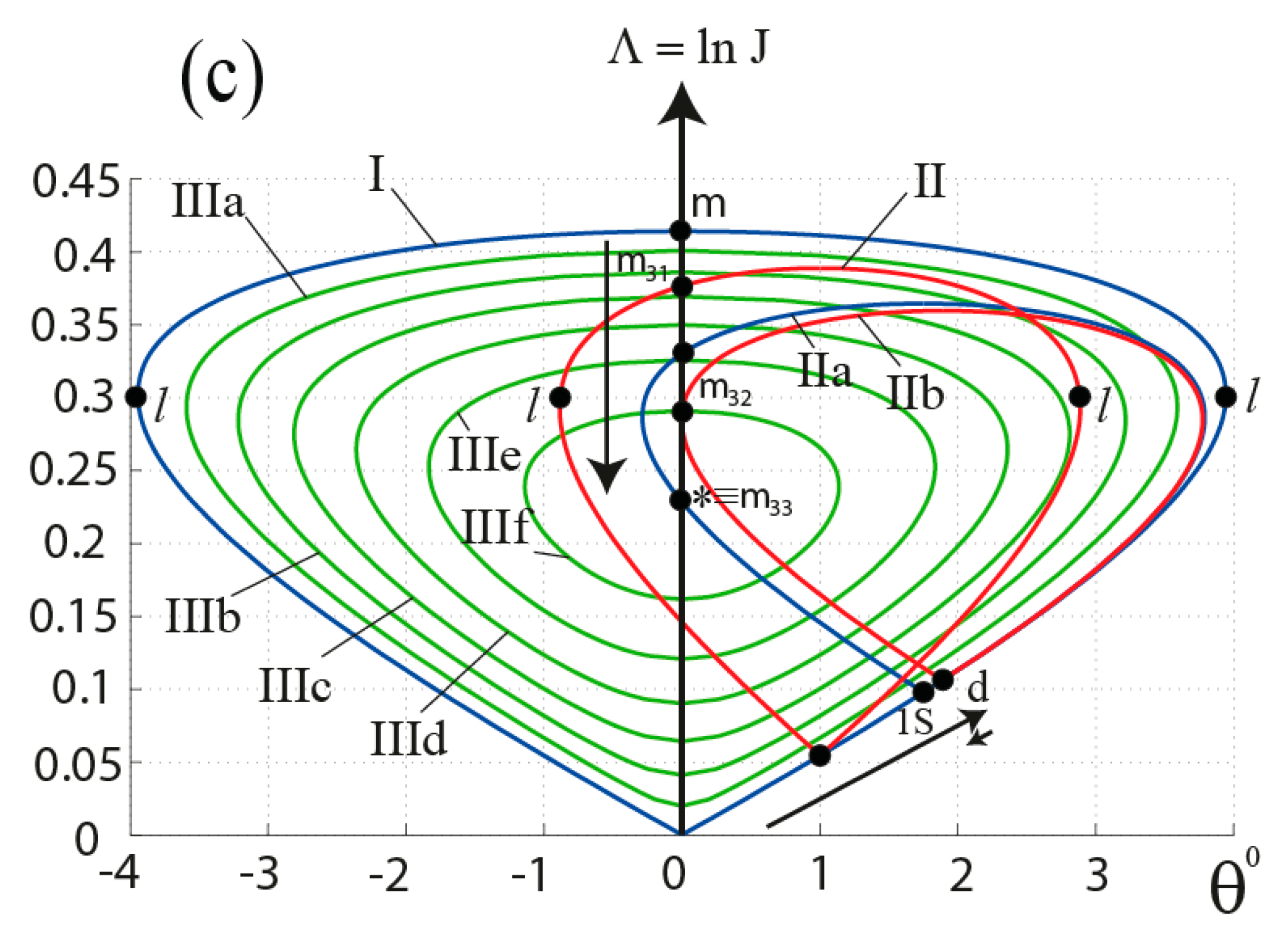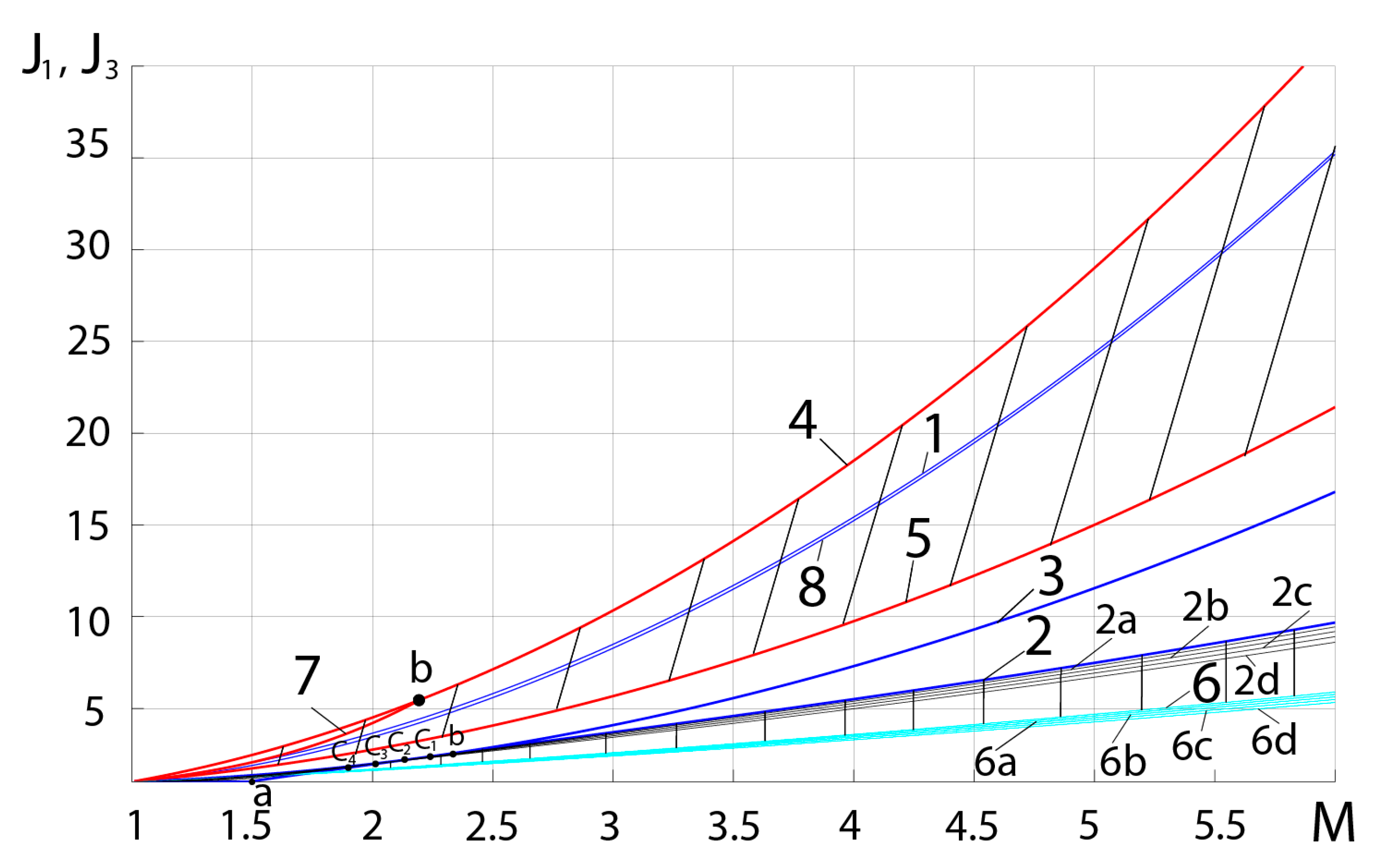Stationary Mach Configurations with Pulsed Energy Release on the Normal Shock
Abstract
:1. Introduction
2. Model and Methods
3. Analytical Results: Description of the Existence Domain of Stationary Mach Configurations
3.1. Stationary Mach Configurations in a Perfect Gas Flow with a Constant Adiabatic Index and without Real Gas Effects
3.2. Influence of the Pulsed Energy Release at the Main Shock
3.3. Influence of Adiabatic Index Variation Due to Real Gas Effects
4. Conclusions
- -
- -
- A more complex nature of real gas effects on strong shock waves, which is not always described by a one-parameter model of the “effective adiabatic index” with a sufficient degree of accuracy and reliability;
- -
- The ambiguity of the solution for triple-shock configurations of shock waves, especially at large flow Mach numbers with a reduced gas adiabatic index (comparing with air, for example, in gaseous hydrocarbons).
Author Contributions
Funding
Conflicts of Interest
References
- Landau, L.D.; Lifshitz, E.M. Course of Theoretical Physics. Fluid Mechanics; Pergamon Press: Oxford, UK, 1987; Volume 6, 552p. [Google Scholar]
- Adrianov, A.L.; Starykh, A.L.; Uskov, V.N. Interference of Stationary Gasodynamic Discontinuities; Nauka: Novosibirsk, Russia, 1995; 180p. (In Russian) [Google Scholar]
- Henderson, L.F. On the confluence of three shock waves in a perfect gas. Aeronaut. Q. 1964, 15, 181–197. [Google Scholar] [CrossRef]
- Uskov, V.N.; Chernyshov, M.V. Special and extreme triple shock-wave configurations. J. Appl. Mech. Tech. Phys. 2006, 47, 492–504. [Google Scholar] [CrossRef]
- Hekiri, H.; Emanuel, G. Shock wave triple point morphology. Shock Waves 2011, 21, 511–521. [Google Scholar] [CrossRef]
- Hekiri, H.; Emanuel, G. Structure and morphology of a triple point. Phys. Fluids 2015, 27, 056102. [Google Scholar] [CrossRef]
- Chernyshov, M.V. Extreme Triple Configurations with Negative Slope Angle of the Reflected Shock. Russ. Aeronaut. 2019, 62, 259–266. [Google Scholar] [CrossRef]
- Uskov, V.N.; Mostovykh, P.S. Triple configurations of travelling shock waves in inviscid gas flows. J. Appl. Mech. Tech. Phys. 2008, 49, 347–353. [Google Scholar] [CrossRef]
- Gvozdeva, L.G.; Gavrenkov, S.A. Formation of triple shock configurations with negative reflection angle in steady flow. Tech. Phys. Lett. 2012, 38, 372–374. [Google Scholar] [CrossRef]
- Gvozdeva, L.G.; Silnikov, M.V.; Gavrenkov, S.A. Triple shock configurations with negative angle of reflection. Acta Astronaut. 2015, 116, 36–42. [Google Scholar] [CrossRef]
- Gavrenkov, S.A.; Gvozdeva, L.G. Numerical investigation of the onset of instability of triple shock configurations in steady supersonic gas flows. Tech. Phys. Lett. 2012, 38, 587–589. [Google Scholar] [CrossRef]
- Shoev, G.V.; Ivanov, M.S. Numerical study of shock wave interaction in steady flows of a viscous heat-conducting gas with a low ratio of specific heats. Thermophys. Aeromech. 2016, 23, 343–364. [Google Scholar] [CrossRef]
- Chernyshov, M.V.; Kapralova, A.S.; Savelova, K.E. Ambiguity of solution for triple configurations of stationary shocks with negative reflection angle. Acta Astronaut. 2021, 179, 382–390. [Google Scholar] [CrossRef]
- Uskov, V.N.; Mostovykh, P.S. The flow gradients in the vicinity of a shock wave for a thermodynamically imperfect gas. Shock Waves 2016, 26, 693–708. [Google Scholar] [CrossRef] [Green Version]
- Uskov, V.N.; Chernyshov, M.V. Stationary Mach configurations, their features and optimality. Probl. Def. Eng. 2008, 11–12, 22–25. (In Russian) [Google Scholar]
- Ivanov, M.S.; Kudrjavtsev, A.N.; Trotsjuk, A.V.; Fomin, V.M. Method of Organization of Detonation Combustion Chamber of Supersonic Ramjet. Engine. Patent on Invention RU 2285143 C2, 10 December 2004. (In Russian). [Google Scholar]
- Chernyshov, M.V.; Murzina, K.E.; Matveev, S.A.; Yakovlev, V.V. Shock-wave structures of prospective combined ramjet engine. IOP Conf. Ser. Mater. Sci. Eng. 2019, 618, 012068. [Google Scholar]
- Savelova, K.E.; Alekseeva, M.M.; Matveev, S.A.; Chernyshov, M.V. Shock-wave structure of prospective combined jet engine. J. Phys. Conf. Ser. 2021, 1959, 012043. [Google Scholar] [CrossRef]
- Ben-Dor, G. Shock Wave Reflection Phenomena. Springer: Berlin/Heidelberg, Germany; New York, NY, USA, 2007; 342p. [Google Scholar]
- von Neumann, J. Oblique Reflection of Shock Waves; Collected Works; Pergamon Press: London, UK, 1963; Volume 6, pp. 238–299. [Google Scholar]
- Denisov, Y.N. Gas Dynamics of Detonation Structures; Mashinostroenie: Moscow, Russia, 1989; 176p. (In Russian) [Google Scholar]
- Li, H.; Ben-Dor, G.; Grönig, H. Analytical Study of the Oblique Reflection of Detonation Waves. AIAA J. 1997, 35, 1712–1720. [Google Scholar] [CrossRef]
- Medvedev, A.E. Reflection of an oblique shock wave in a reacting gas with a finite relaxation-zone length. J. Appl. Mech. Tech. Phys. 2001, 42, 211–218. [Google Scholar] [CrossRef]
- Li, J.; Ning, J.; Le, J.H.S. Mach reflection of ZDN detonation wave. Shock Waves 2015, 25, 293–304. [Google Scholar] [CrossRef]
- Jing, T.; Ren, H.; Li, J. Onset of the Mach reflection of Zel’dovich—Von Neumann—Döring detonations. Entropy 2021, 23, 314. [Google Scholar] [CrossRef]
- Smirnov, N.N.; Betelin, V.B.; Nikitin, V.F.; Phylippov, Y.G.; Koo, J. Detonation engine fed by acetylene-oxygen mixture. Acta Astronaut. 2014, 104, 134–146. [Google Scholar] [CrossRef]
- Smirnov, N.N.; Penyazkov, O.G.; Sevrouk, K.L.; Nikitin, V.F.; Stamov, L.I.; Tyurenkova, V.V. Detonation onset following shock wave focusing. Acta Astronaut. 2017, 135, 114–130. [Google Scholar] [CrossRef]
- Bulat, P.V.; Volkov, K.N. Detonation jet engine. Part I—Thermodynamic cycle. Int. J. Environ. Sci. Educ. 2016, 11, 5009–5019. [Google Scholar]
- Bulat, P.V.; Volkov, K.N. Detonation jet engine. Part II—Construction features. Int. J. Environ. Sci. Educ. 2016, 11, 5020–5033. [Google Scholar]
- Davletshin, I.A.; Mikheev, N.I.; Paerelii, A.A. Pressure Recovery in Planar Diffuser at Pulsatory Flow Regimes. Rus. Aeronau. 2016, 59, 95–99. [Google Scholar] [CrossRef]
- Chernyshov, M.V.; Tolpegin, O.A. Optimal regular reflection of oblique shocks. Acta Astronaut. 2019, 163, 225–231. [Google Scholar] [CrossRef]
- Korobeinikov, V.P.; Levin, V.A. Strong explosion in a combustible gas mixture. Fluid Dyn. 1969, 4, 30–32. [Google Scholar] [CrossRef]
- Levin, V.A.; Markov, V.V. Initiation of detonation by concentrated release of energy. Combust. Explos. Shock Waves 1975, 11, 529–536. [Google Scholar] [CrossRef]







Publisher’s Note: MDPI stays neutral with regard to jurisdictional claims in published maps and institutional affiliations. |
© 2021 by the authors. Licensee MDPI, Basel, Switzerland. This article is an open access article distributed under the terms and conditions of the Creative Commons Attribution (CC BY) license (https://creativecommons.org/licenses/by/4.0/).
Share and Cite
Chernyshov, M.V.; Kapralova, A.S.; Matveev, S.A.; Savelova, K.E. Stationary Mach Configurations with Pulsed Energy Release on the Normal Shock. Fluids 2021, 6, 439. https://doi.org/10.3390/fluids6120439
Chernyshov MV, Kapralova AS, Matveev SA, Savelova KE. Stationary Mach Configurations with Pulsed Energy Release on the Normal Shock. Fluids. 2021; 6(12):439. https://doi.org/10.3390/fluids6120439
Chicago/Turabian StyleChernyshov, Mikhail V., Anna S. Kapralova, Stanislav A. Matveev, and Karina E. Savelova. 2021. "Stationary Mach Configurations with Pulsed Energy Release on the Normal Shock" Fluids 6, no. 12: 439. https://doi.org/10.3390/fluids6120439





